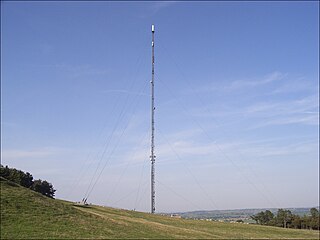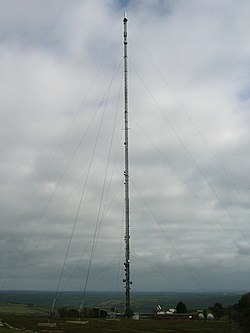The Sutton Coldfield transmitting station is a broadcasting and telecommunications facility located in Sutton Coldfield, Birmingham, England. In terms of population covered, it is the third most important transmitter in the UK, after Crystal Palace in London and Winter Hill near Bolton.

The Belmont transmitting station is a broadcasting and telecommunications facility next to the B1225, 1 mile (1.6 km) west of the village of Donington on Bain in the civil parish of South Willingham, near Market Rasen and Louth in Lincolnshire, England. It is owned and operated by Arqiva.

The Mendip transmitting station is a broadcasting and telecommunications facility on the summit of Pen Hill, part of the Mendip Hills range in Somerset, England, at 305 metres (1,001 ft) above sea level. The station is in St Cuthbert Out civil parish, approximately 2 miles (3.2 km) north-east of Wells. Its mast, 293 m (961 ft) high, was built in 1967 and is the tallest structure in South West England. The mast broadcasts digital television, FM analogue radio and DAB digital radio, and had broadcast analogue colour television from 1967 until 2010.

The Winter Hill transmitting station is a broadcasting and telecommunications site on Winter Hill, at the southern boundary of the Borough of Chorley, Lancashire, England, and above Bolton. It is owned and operated by Arqiva.

The Arfon transmitting station is a facility for FM, DAB digital radio and television transmission near the villages of Nebo and Nasareth in Gwynedd, northwestern Wales. It includes a 308.5 m (1,012 ft) guyed mast with antennas attached at various heights. The mast is surmounted by a television transmitting antenna, which brings the total height of the structure to 317.4 m (1,041 ft), making it the tallest structure in Wales. It is owned and operated by Arqiva.

The Moel-y-Parc transmitting station is situated on Moel y Parc, a hill in north-east Wales at the northern end of the Clwydian range, close to the town of Caerwys and several miles (kilometres) north-east of Denbigh. It was built in 1962/1963 by the IBA to bring 405-line VHF ITV television to North Wales and it has been on the air since 1963. Its original height of 229 metres (751 ft) made it the tallest structure in North Wales and it stands on land that is itself about 335 metres (1,099 ft) above sea level. In 1965, VHF television transmissions from the BBC commenced from the site.
The Llanddona transmitting station is a broadcasting and telecommunications facility, situated at Llanddona, near Beaumaris, on the isle of Anglesey, Wales. It comprises a 106.7 metres (350 ft) guyed mast with antennas attached at various heights. It is owned and operated by Arqiva.

The Wenvoe transmitting station, officially known as Arqiva Wenvoe, is the main facility for broadcasting and telecommunications for South Wales and the West Country. It is situated close to the village of Wenvoe in the Vale of Glamorgan, Wales, in the UK.
The Caldbeck transmitting station is a broadcasting and telecommunications facility, situated close to the village of Caldbeck, in Cumbria, England. It is owned and operated by Arqiva.
The Oxford transmitting station is a broadcasting and telecommunications facility, situated on land 129.5 metres (425 ft) above Ordnance Datum to the north east of the city of Oxford, in Oxfordshire, England. It has a guyed steel lattice mast which is 154.4 metres (507 ft) in height to the top of the main steel structure. The UHF television antenna, which consist of a vertical array of transmitting panels, is mounted above the steel structure. The total height of the mast to the top of this UHF antenna is 165.7 metres (544 ft). It is owned and operated by Arqiva.

The Haverfordwest transmitting station is a broadcasting and telecommunications facility located at Woodstock about 13 km (8 mi) to the north east of the town of Haverfordwest, in Pembrokeshire, Wales. It was originally built by the BBC, entering service in early 1964 acting as a main transmitter for the 405-line VHF television system, and as a repeater for Band 2 VHF FM radio received off-air from Blaenplwyf transmitting station. It is now owned and operated by Arqiva.

Huntshaw Cross transmitting station is a telecommunications facility serving North Devon including the towns of Barnstaple and South Molton. It broadcasts television, radio and mobile telephone services and is currently owned by Arqiva. It is located on the B3232 road at Huntshaw, Great Torrington. Grid reference SS527220. The mast is 164 metres (538 ft) high.

Storeton transmitting station is a television transmitter being a member of both the Winter Hill group of transmitters and of the Moel-y-Parc group of transmitter, and an FM radio transmitter, with transmitting antennas affixed to a mast located on Storeton Ridge, Higher Bebington, Wirral, UK. The site is owned and operated by Arqiva. It was originally solely an analogue TV relay of the Winter Hill transmitter. The 45 metre-high (150 ft-high) mast is situated at an elevation of 65.5 metres (215 ft). Thus, the top of the mast has an overall height of 110.5 metres (363 ft) above sea level. Construction of the mast was completed in 1980. As of 2009, the TV transmitter serves approximately 45,000 homes.

The Carmel transmitting station, located half a mile (0.8km) SSW of the village of Carmel in Carmarthenshire, has been broadcasting terrestrial TV and radio services since the mid-1970s. The TV coverage area for the Carmel transmission station includes most of Carmarthenshire, the southern and eastern parts of Pembrokeshire; the southern fringes of Powys and Ceredigion; the northern part of Swansea. The Carmel signal is also receivable in parts of Neath Port Talbot, Bridgend and Rhondda Cynon Taff. Places as far away as Merthyr Tydfil and the north Devon coast are also able to receive signals from Carmel.

The Blaenplwyf transmitting station is a broadcasting and telecommunications facility located near the village of Blaenplwyf about 10 kilometres (6 mi) to the south west of the town of Aberystwyth, in Ceredigion, Wales. It was originally built by the BBC, entering service in October 1956 acting as a main transmitter for BBC Band II VHF FM radio.

The Kilvey Hill transmitting station was originally built at the summit of Kilvey Hill in Swansea, Wales, by the BBC in 1967 as a relay for VHF and UHF television. VHF television came on air a few months before the UHF services. As built, the station did not radiate VHF FM radio, this was added later. Currently, the hill's transmitters cater for viewers and listeners in the Swansea and Neath Port Talbot area. The transmission station located on top of Kilvey Hill is owned and operated by Arqiva.
The Brecon transmitting station was originally built by the IBA in 1970 as a relay for VHF 405-line analogue television: one of the last 405-line TV stations to be built in Britain. As built, it consisted of a 46 m guyed lattice mast carrying the aerials at the top. This structure was built about 300 m NW of Slwch Tump Iron Age hill fort on the slopes of a 240 m hill known as "The Slwch" overlooking the town. The VHF television feed was provided off-air from Abergavenny, about 25 km to the southeast - itself an off-air relay of St. Hilary near Cardiff.
The Llandrindod Wells transmitting station is a broadcasting and telecommunications facility located on high ground about midway between Llandrindod Wells and Rhayader, in Powys, Wales. It was originally built by the BBC, entering service in 1961 transmitting the now-defunct 405-line VHF television system and the original three FM radio services.
The Abergavenny transmitting station was originally built by the IBA in 1969 as a relay for BBC and ITV VHF 405-line analogue television. It consists of a 46 m guyed lattice mast carrying the aerials at the top. This structure was built on a 440 m hill known as Gilwern Hill overlooking the towns of Gilwern and Abergavenny in Monmouthshire, South Wales. The band III VHF television feeds were provided off-air from St. Hilary and Wenvoe, both near Cardiff.
The Cynwyl Elfed television relay station is sited on high ground to the east of the village of Cynwyl Elfed to the north of Carmarthen. It was originally built in mid 1989 as a fill-in relay for UHF analogue colour television covering the village of Cynwyl Elfed and the surrounding community. It consists of a 14 m self-supporting lattice steel mast standing on a hillside which is itself about 115 m above sea level. The transmissions are beamed west to cover the target. The Cynwyl Elfed transmission station is owned and operated by Arqiva.














